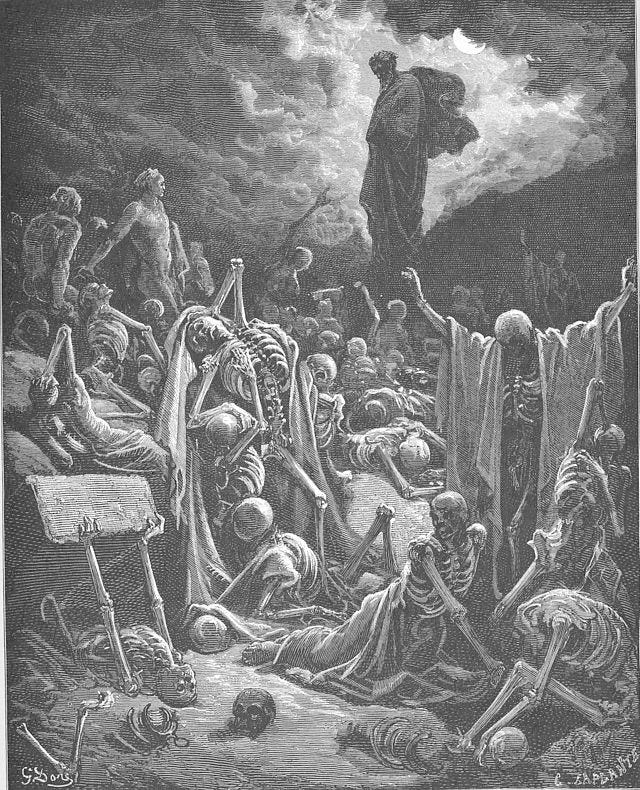Sunday Lectionary: Ezekiel's Valley of Dry Bones
Greetings friends - in July, this newsletter will be celebrating its first birthday! I’d love to think more about how the newsletter is serving the community to people who subscribe, so I wonder if you’d be kind enough to give me some feedback by answering these three questions? It should just take a few minutes and I would be so grateful to hear from you!
This Sunday’s Old Testament lectionary reading is one of my favorite passages in the Bible. It speaks of hope and resurrection and has been key to my own vocational journey.
Speaking of vocation - some of you will be aware that I’m due to be ordained deacon at the beginning of July which is hugely exciting! This means that in the next two months, I’ll be moving house and beginning a curacy, so as I adjust to all of that, I will take a short break from this newsletter. But fear not! I will be back in August to provide you with your bi-monthly old testament lectionary notes.
But enough of all that - on to the text!
Context
The first ever edition of this newsletter focussed on the book of Ezekiel, so if you’d appreciate a deeper look at the book you’ll find some useful information here:
If you read the previous newsletter you’ll be well aware of the way in which the exile looms large in the background of the book of Ezekiel. From chapter 33 onwards, the book is made up of a collection of oracles about the future of the nation of Israel following the exile.
Our text belongs to a unit (36:16-37:14) which is primarily concerned with the purification of the land as a preparation for the people to return to it. The text is made up of several different oracles, which range from being encouraging to disturbing in their content. As discussed in the newsletter linked above, some of Ezekiel’s more visceral language makes sense through the lens of trauma connected to the exile, but nevertheless, it can make for tricky reading.
Just after this portion of the text, we read about Ezekiel’s vision for the restored temple, after which the book comes to an end. In order for the temple to be re-established, which we eventually read about in Ezra-Nehemiah, the land must be prepared, and in particular, made holy. It is this task of making the land holy that our lectionary text concerns itself with.
127.Ezekiel’s Vision of the Valley of Dry Bones, Dora, 1866 - wikimedia.commons
Content
One of the most striking features of this passage is its depiction of the bones. Verses 7-8 of the text says
‘So I prophesied as I had been commanded, and as I prophesied, suddenly there was a noise, a rattling, and the bones came together, bone to its bone. 8 I looked, and there were sinews on them, and flesh had come upon them, and skin had covered them, but there was no breath in them’
As we learn from biblical law, holiness requires a strict separation between life and death. That’s why texts like Leviticus have such stringent rules about what happens to a dead body (see Lev 11).
In order for the land to be pure and ready for God to dwell there and for the temple to be rebuilt, then, all traces of death had to be removed from it. We know that the events of the exile were violent and many would have died during the sack of Jerusalem. It is likely that the bones in the passage are a reflection of the death that resulted from the exile. This is where the mass clean-up operation of chapter 37 comes in!
Restoration / resurrection imagery
The imagery of the bones is strange and reminiscent of the violence of the exile, but it is also powerful resurrection imagery that is well suited to this Easter season.
The phrase "‘I will cause breath to enter you” chimes nicely with Jesus’ words in John 14 about the coming of the Holy Spirit, especially since the word for breath in Hebrew (רוּחַ - ‘ru’ach’)has the sense also of ‘spirit.
So I hope you’re able to draw some of these themes together as you read, hear or preach on this wonderful text over the weekend.





